Important though the ecological footprint is, the way it is calculated means the estimate that Saanich’s ecological footprint is equivalent to four planets is an underestimate.
That is because a lot of different activities — energy use, food growing, materials for buildings, modes of transportation, waste disposal — are all expressed as a measure of land area used. It is a useful measure of our impact on the Earth, but it is incomplete, because not everything can be converted to an area of land.
We need to be aware of this, so we do not only focus on the footprint and neglect other important ways in which what we do in Saanich has a harmful impact on the local, regional and global ecosystems that sustain us and all life.
So this week, I want to explore the first two of three key areas of human impact not adequately captured by the ecological footprint, but that still need to be addressed if we are to become a One Planet Region. These map to the three global ecological crises described by the UN — climate change, biodiversity loss and pollution.
The ecological footprint does not measure climate change or energy use per se, but measures carbon emissions and converts that into the area of land that would need to be planted in trees to absorb that amount of emissions.
However, that does not work for methane — a short-lived but potent greenhouse gas — because it is not taken up and sequestered by nature. So the footprint does not account for methane, despite its global-warming potential.
Back in 2009, researchers at the University of Limerick in Ireland estimated the impact of including methane in Ireland’s ecological footprint. They found that if the global-warming potential of methane were included, Ireland’s footprint would be about 20 per cent higher.
This underestimate of the footprint assumes greater significance when we recognize that the amount of methane being released to the atmosphere is far greater than corporations and governments have been telling us.
Gas systems leak at all points from extraction through transmission in pipelines to end use. If the gas is turned into LNG, there are also leaks during the liquefaction and shipping stages.
The crucial question is how much they leak. A 2023 article in Environmental Research Letters reported that leakage of anywhere between two and nine per cent (depending on the timeframe used) still means that replacing coal with gas is beneficial.
But that same article noted that leakage rates in the U.S. can be as high as 66 per cent, while the recent Production Gap Report from, among others, the UN Environment Programme, notes that improved measurements of “methane leakage along the gas supply chain have substantially reduced the expected climate benefits of replacing coal with gas.”
The second ecological crisis that is not included in an estimate of Saanich’s ecological footprint is the loss of biodiversity. The Global Footprint Network clearly states: “The Ecological Footprint is not an indicator of the state of biodiversity, and the impact of a particular activity or process on biodiversity does not directly affect the Ecological Footprint calculation for that activity.”
However, the network adds, “the Ecological Footprint can be used as a large-scale indicator of the underlying drivers or pressures that cause biodiversity loss.”
So we need to recognize both that a four (or more) planet footprint places an enormous strain on nature and also document all the ways in which we harm ecosystems and reduce biodiversity, whether it be damaging local streams and their salmon runs or eating a high-meat diet sourced in part from the conversion of the Amazon rainforest to pasture.
The third impact that is not well represented by the ecological footprint is our use and dispersal of toxic chemicals: “Toxics and pollutants released from the human economy that cannot in any way be absorbed or broken down by biological processes … cannot be directly assigned an Ecological Footprint,” notes the network.
Next week, I will discuss the increasingly alarming toll of these chemicals on both human health and the health of other species and entire ecosystems, and what we need to do locally about that, as well as about methane emissions and biodiversity loss.
Dr. Trevor Hancock is a retired professor and senior scholar at the University of Victoria’s School of Public Health and Social Policy



